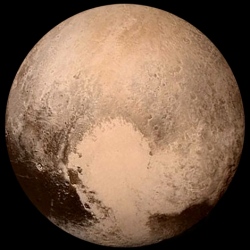
One of the most interesting features photographed by New Horizons is the heart-shaped lobe on the planet, called Sputnik Planum. Scientists were baffled by the lack of craters on the plain, which suggests that the surface is relatively new. Could this mean that Pluto is geologically active?
Researchers think that the lobe is only about 10 million years old, a fraction of the 4.5 billion, year lifespan of the solar system. The finding suggests that Pluto has some capability of producing great heat or pressure that reshapes rocks and creates new geologic features.
According to New Horizons lead investigator, Alan Stern, “It’s a huge finding that small planets can be active on a massive scale, billions of years after their creation.” The most recent photo of Pluto was presented at the Division of Planetary Sciences of the American Astronomical Society meeting in National Harbor, MD on Monday.
The team announced a number of other findings at the meeting too; they presented information about Pluto’s thin, hazy atmosphere, and revealed that they had discovered what they believed to be an ice volcano on the surface of the planet.
The lack of craters on Sputnik Planum however remains one of the most compelling discoveries about Pluto. The surface has not been exposed to the meteors and asteroids cruising through space for very long, suggesting that the new surface was added quite recently.
Some regions on Pluto are much older, even approaching ages of 4 billion years. Stern believes that Pluto has been geologically active for much of its life. Since it is so small, any heat that would have remained after the planet’s formation would have dissipated into space long ago. Researchers still don’t know what could be driving the geologic process on Pluto, but the data presented by New Horizons has given them a good start for figuring it out.
